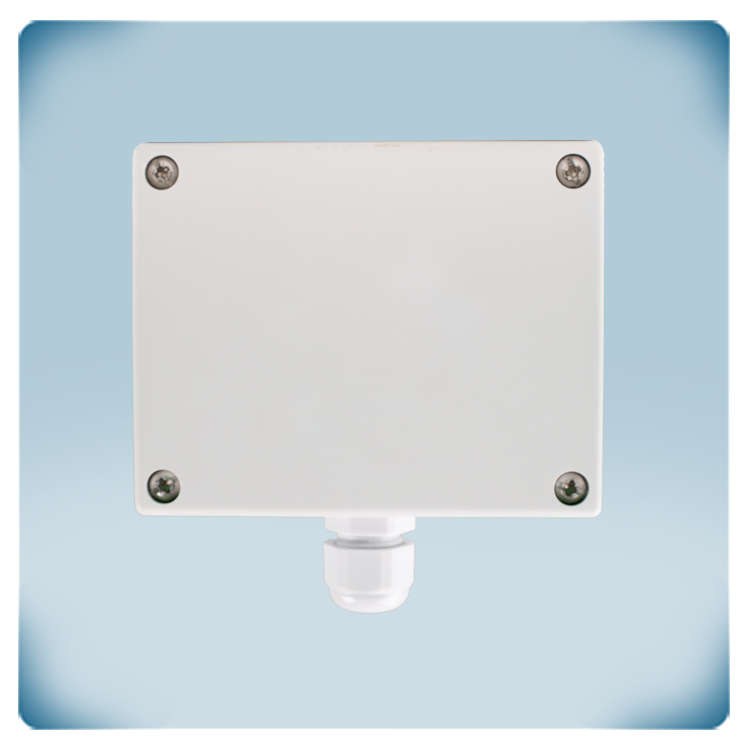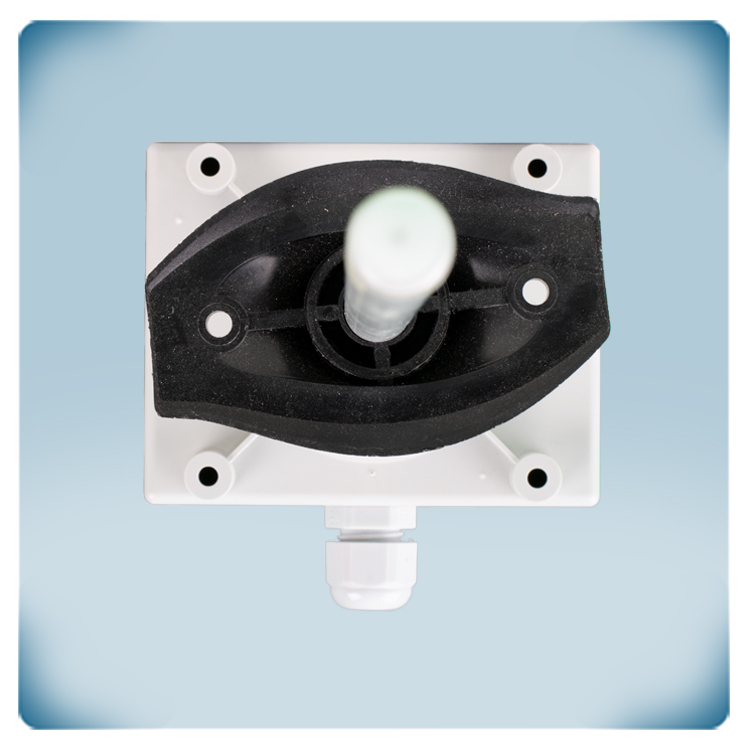EU declaration conformity
Duct temperature | humidity controller | 24 V AC - V DC
Product description
This device controls HVAC systems by measuring temperature and relative humidity in air ducts.
Measurement and Control:
It measures temperature and humidity, and calculates the dew point. Based on measured values, it directly manages devices like fans and dampers via a single analog output. You can select the output type and adjust the temperature/humidity ranges. It also provides fan speed control based on temperature and humidity.
Power and Connection:
It operates on 24 VAC or 24 VDC and offers easy connection using spring contact terminal blocks.
Communication and Customization:
All data and settings are accessible via Modbus RTU. The firmware can be updated using a bootloader via Modbus RTU.
Documents
Additional specifications and description
What is the Importance of HVAC Transmitters in Buildings?
HVAC systems in commercial buildings, industrial facilities, and residential settings rely on these transmitters. They enable precise temperature and humidity control, assisting in the maintenance of comfortable indoor environments, lowering energy consumption, and ensuring proper air quality.
How Does the Sensor Measure and What Are the Best Installation Practices?
This HVAC transmitter measures temperature and relative humidity in air ducts. The dew point is calculated based on these measurements. This sensor works best if it is installed in a straight section of the air duct. Avoid installing in turbulent air zones near filters, fans, cooling coils, and so on. Position the sensor correctly in relation to the airflow direction. More detailed information can be found in the mounting instructions.
How Does the Sensor Control Devices and How is Its Output Managed?
One output is controlled by the sensor algorithm. This output can be used to operate an EC fan, an AC fan speed controller, or a damper actuator. The output value varies in direct proportion to the measured temperature and relative humidity. For example, as the temperature or relative humidity approaches their maximum limit, the fan speed increases or the damper opens. The control value can be accessed via the analogue output and Modbus RTU.
What Are the Wiring and Power Supply Requirements for the Sensor?
The cage clamp terminal blocks reduce wiring and installation time. They eliminate the need for routine maintenance and guarantee a reliable contact for solid or stranded wires. This sensor can be supplied with 24 V DC or with 24 V AC and is intended for 3-wire connection. The ground of the output (GND) is internally connected to the ground of the supply voltage (V-). Make sure not to connect this common ground to other devices that are powered by a DC voltage.
What Configuration is Needed for the Sensor and How Can Its Settings Be Customized?
This sensor requires very little setup. Once installed, it is almost immediately usable. Temperature and relative humidity are frequently region- and season-dependent. During installation, these parameters are still set to the correct values. The other default settings will most likely be adequate for most applications. They can, however, be adjusted via the respective Modbus registers if necessary. To make it compatible with other devices, you can choose a different output type, for example: Modbus RTU; 0-10 VDC; 0-20 mA; 0-100% PWM. You also also deactivate one of the readings. If you want to control your fan based on humidity only, you can deactivate the temperature reading in the corresponding Modbus register. The Modbus register map contains a comprehensive list of all programmable settings.
What Are the Manufacturing Quality, Calibration, and Protection Features of the HVAC Transmitter?
This HVAC transmitter is made in Europe. Each sensor is calibrated and tested in our factory. We only use high-quality sensor elements and components. This guarantees the HVAC transmitter's long-term stability and accuracy. The enclosure has an IP54 rating for dust and moisture protection. The sensor element is built into the probe of the duct sensor. This probe has an opening to allow direct contact between the air flow and the sensor element. The sensor probe itself is IP20 rated.
∞ Monitoring indoor air quality
How Does the Sensor Measure and What Are the Best Installation Practices?
This HVAC transmitter measures temperature and relative humidity in air ducts. The dew point is calculated based on these measurements. This sensor works best if it is installed in a straight section of the air duct. Avoid installing in turbulent air zones near filters, fans, cooling coils, and so on. Position the sensor correctly in relation to the airflow direction. More detailed information can be found in the mounting instructions.

How Does the Sensor Control Devices and How is Its Output Managed?
One output is controlled by the sensor algorithm. This output can be used to operate an EC fan, an AC fan speed controller, or a damper actuator. The output value varies in direct proportion to the measured temperature and relative humidity. For example, as the temperature or relative humidity approaches their maximum limit, the fan speed increases or the damper opens. The control value can be accessed via the analogue output and Modbus RTU.
What Are the Wiring and Power Supply Requirements for the Sensor?
The cage clamp terminal blocks reduce wiring and installation time. They eliminate the need for routine maintenance and guarantee a reliable contact for solid or stranded wires. This sensor can be supplied with 24 V DC or with 24 V AC and is intended for 3-wire connection. The ground of the output (GND) is internally connected to the ground of the supply voltage (V-). Make sure not to connect this common ground to other devices that are powered by a DC voltage.
What Configuration is Needed for the Sensor and How Can Its Settings Be Customized?
This sensor requires very little setup. Once installed, it is almost immediately usable. Temperature and relative humidity are frequently region- and season-dependent. During installation, these parameters are still set to the correct values. The other default settings will most likely be adequate for most applications. They can, however, be adjusted via the respective Modbus registers if necessary. To make it compatible with other devices, you can choose a different output type, for example: Modbus RTU; 0-10 VDC; 0-20 mA; 0-100% PWM. You also also deactivate one of the readings. If you want to control your fan based on humidity only, you can deactivate the temperature reading in the corresponding Modbus register. The Modbus register map contains a comprehensive list of all programmable settings.
What Are the Manufacturing Quality, Calibration, and Protection Features of the HVAC Transmitter?
This HVAC transmitter is made in Europe. Each sensor is calibrated and tested in our factory. We only use high-quality sensor elements and components. This guarantees the HVAC transmitter's long-term stability and accuracy. The enclosure has an IP54 rating for dust and moisture protection. The sensor element is built into the probe of the duct sensor. This probe has an opening to allow direct contact between the air flow and the sensor element. The sensor probe itself is IP20 rated.
∞ Monitoring indoor air quality







.webp)
.webp)
.webp)
.webp)
.webp)
.webp)




Remarks, reviews & ratings